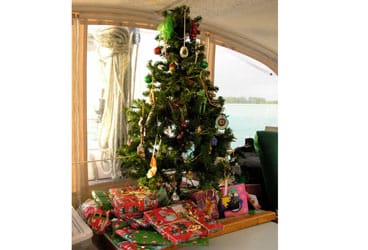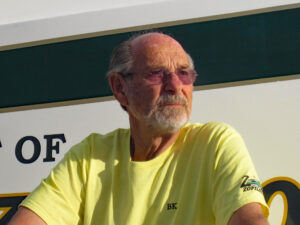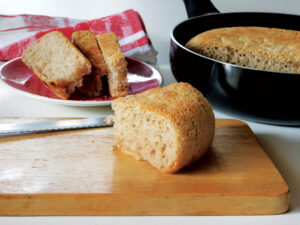
Originally posted on December 23, 2010
I posed the question to our friends Mark and Julie on Rachel, as we were all sweating on the Río Dulce in Guatemala: “So where do you want to spend Christmas this year?” Granted, it was only June. But it seemed a nice notion to think of Christmas, which, for me, conjures images of snow, sledding, ice-skating, and the cold palm of winter on my cheek. Just thinking about it would cool me off.
You know that holiday beer ad that shows a palm tree outlined in Christmas lights? It never worked for me. For my family, Christmas has always meant winter in a real sense. It means a big, fragrant fir tree in the living room, one so tall that you have to trim the bottom off just to get it in the door and under the ceiling. It means slumber parties in front of the glowing woodstove and air so cold and clear that at night, the stars seem to crack the sky. After all, the song does say “Jack Frost nipping at your nose,” not “Sand fleas nipping at your ankles.” Santa doesn’t wear a fur-lined Speedo, and you leave him cookies, not a cold cerveza.
I still feel this way, though this will be our third Christmas aboard Osprey, and we’ll be spending it farther than ever from the places that my wandering heart calls home. But like everything we do out here, the farther we go, the more we learn about ourselves and how we see the world. Our first Christmas aboard, we bought a little artificial tree—something I swore that I’d never do—with colored lights already attached. We set it up out in the cockpit, and when we plugged it in for the first time and the lights came on, we all cheered. Then we trimmed it with the few ornaments that we’d been able to pack into two meager cigar boxes, and it was all over so fast that my daughter cried. “It’s supposed to take longer,” she said.
The tree, though, began to take on a life of its own. We roped it into place and sailed all through the Bahamas with it, the ornaments swaying and jingling merrily when we got into rough water. Its bright lights made a distinctive boat beacon when we returned from a night of socializing. We liked it so well—and what it seemed to signify, a piece of “home”—that we left it up for half of that first year. We boxed up the traditional ornaments and began hanging shells and pieces of sargasso weed, pretty fragments of driftwood and sea fans we’d found on the beach, anything it seemed to want.
The tree became something new, something we hadn’t expected or maybe even hoped for that first rather homesick Christmas, when it seemed like the traditions we’d loved were just one more thing we had to give up when we left the land-bound life. Last year, when it was time to set the tree up again—we did take it down by September or so—we took our time trimming it. We added new ornaments we’d found and made during our travels. The tree began to reflect who we were becoming, not who we’d been. We were making new traditions, inspired by our life afloat as wanderers, and while I’d always wish for the glow and scent of a big fir tree and all of the memories it brings, I realized that this little plastic tree had become part of a new set of memories, and so had earned its place.
As have we. I’m not sure where we’ll be this Christmas. Somewhere Santa wears a fur-lined Speedo, no doubt. I’ll look up at the Southern Cross and know I’m far from the places I still call home. But the tree will twinkle under that fine velvet sky, my kids will dream of sugarplums, and home I will be.








